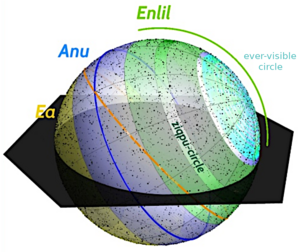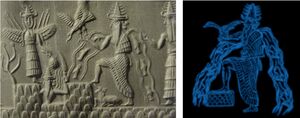E2-a (Sumerian Enki)
E2-a
dEnki = dEa (𒀭𒂍𒀀) is the ‘water god’ of Ancient Mesopotamia, in particular the subterranean fresh-water ocean Apsu. In traditional Mespotamian astronomy, Ea’s stellar path is the southernmost in the sky. Thus, it is natural for him to be closely related to the southern constellation mulku6, ‘The Fish’ (Piscis Austrinus). Yet, he is also represented in a constellation next to it, the constellation of mulGU.LA, The Great One (Aquarius), as this is a byname of the god.
Concordance, Etymology, History
Kurtik with Hilder, Hoffmann, Horowitz, Kim
= dDIŠ; Ea, god of the subterranean ocean Apsu, god of wisdom, lord of fortune and patron of divination; played an important role in the Mesopotamian sky. Among his epithets ka-bi-su qe2-reb šamê rūqūti "He stands out in the middle of the high heavens" [Tallqvist 1938[1], 107]. The following astral aspects of Ea can be distinguished.
- In the subdivision of the sky into three regions, there are the "Stars (or 'ways') of Enlil, Anu and Ea", with the stars south of the equatorial zone associated with Ea. Such subdivisions are found for the first time in the Hittite prayers to the Gods of the Night [KUB[2] IV, 47 r. 46-47; Van der Toorn 1985, 130]. The expressions used were kakkabāni (MUL.MEŠ) šu-ut dE2-a "Stars of Ea" and ḫarrān (KASKAL) šu-ut dE2-a "The way (or 'road') of Ea"; in Enūma eliš (V 8): man-za-az dEn-lil2 u dE2-a "the (heavenly) stations of Enlil and Ea", identified with mulAPIN and mulKU6, 'The Plow and 'The Fish' (see Horowitz 2014[3]: 6-7). Lists of Ea stars:
- A number of cases emphasize the affiliation between the luminaries' with the stars of Ea, including
- (a) mulKU6 dE2-a, mulGU.LA dE2-a, mulNUNki dE2-a in MUL.APIN I ii 19-20, and the Astrolabe tradition (Horowitz 2017: 98),
- (b) múlBIR dE2-a in the Astrolabe tradition (Horowitz 2017: 111),
- (c) mulKU6 dE2-a the name of Jupiter in the month of Adar in K.5990 :13 [IIIR, 53:2].
- "Ea star" as a designation for planets in astrological texts;
- DIŠ MUL dE2-a a-dir GAN2.ZI NU SI.SA2 ...: dGU4.UD ina mulSUḪUR.MAŠ2ku6 u2-tan-nat-ma
- "If the star of Ea is dim, crops will not grow... (it means): Mercury in the Capricorn is low in luster" [ACh Ištar[7], 21:43-44], here "star of Ea" = Mercury in Capricorn;
- DIŠ mulMIN(=dE2-a) mulAŠ.GAN2 KUR-ma [...]: dDil-bat ina mul lúḪUN.G[A2 ...]
- "If the star of Ea reaches the Field [...] (it means): Venus is in the Hired Man [...]" [ACh Ištar[7], 22:3-4] ("star of Ea" = Venus);
- [DIŠ mul dE2]-a ina ŠA3 mulAŠ.GAN2 GUB-iz
- DIŠ MUL dE2-a a-dir GAN2.ZI NU SI.SA2 ...: dGU4.UD ina mulSUḪUR.MAŠ2ku6 u2-tan-nat-ma
For other examples see. [ACh Suppl.[7] 2, 51:12-13, 68 r. 11-13].
Additional
On the astral meaning of Ea see also [Galter 1983[8], 116-120].
Historical Dictionaries
| Kurtik (2022) | Gössmann (1950) |
|---|---|
| = dDIŠ; Эа, бог подземного океана Апсу, бог мудрости, господин судьбы и покровитель предсказательства; играл важную роль на месопотамском небе. Среди его эпитетов ka-bi-su qe2-reb šamê rūqūti «Выступающий посреди небес высоких» [Tallqvist 1938, 107]. Можно выделить следующие астральные аспекты Эа.
(1) В подразделении неба на три региона, «Звезды (или ‘пути’) Энлиля, Ану и Эа», с Эа связаны звезды, расположенные к югу от экваториальной зоны. Впервые такое подразделение встречается в хеттской молитве ночным богам [KUB IV, 47 r. 46–47; Van der Toorn 1985, 130]. Употреблялись выражения: kakkabāni(MUL.MEŠ) šu-ut dE2-a «Звезды Эа» и ḫarrān(KASKAL) šu-ut dE2-a «Путь (или ‘дорога’) Эа»; в Enūma eliš (V 8): man-za-az dEn-lil2 u dE2-a «стоянки Энлиля и Эа» [Landsb.–Kinier Wilson 1961, 156]. Списки звезд Эа: a) 15 звезд Эа в MUL.APIN I ii 19–35, b) 12 звезд Эа в списке 82-5-22,512 [CT 33, 9 r. 15–21], c) 12 звезд Эа в Astr. B [KAV 218, B i 1–28, C 1–12, левый столбец; Horowitz 2014, 37], d) 10 звезд Эа в «Каталоге 30 звезд» (A 1–13, B 1–14) [Oelsner–Horowitz 1997–98, 177]. (2) В ряде случаев подчеркивается принадлежность светила к звездам Эа, в том числе: а) mulKU6 dE2-a, mulGU.LA dE2-a, mulNUNki dE2-a в MUL.APIN I ii 19–20, mulKU6 dE2-a ― имя Юпитера в месяце аддару в К.5990:13 [IIIR, 53:2], b) múlBIR dE2-a в «Каталоге 30 звезд» (Ea 8, В. 11) и, возможно, в Astr. B [KAV 218, B i 17–18; Horowitz 2014, 37], при этом название самой звезды может опускаться и записываться сокращенно как dE2-a [KAV 218, B i 19, 21, 23; Horowitz 2014, 37; Oelsner– Horowitz 1997–98, Ea 8–10]. (3) «Звезда Эа» как обозначение планет в астрологических текстах; DIŠ MUL dE2-a a-dir GAN2.ZI NU SI.SA2 …: dGU4.UD ina mulSUḪUR.MAŠ2ku6 u2-tan-nat-ma «Если звезда Эа тусклая, урожай не вырастет… (это означает): Меркурий в Козероге имеет малый блеск» [ACh Ištar, 21:43–44], здесь «звезда Эа» = Меркурий в Козероге; DIŠ mulMIN(=dE2-a) mulAŠ.GAN2 KUR-ma […] : dDil-bat ina mul lúḪUN.G[A2 …] «Если звезда Эа достигает Поля […] (это означает): Венера в Наемнике […]» [ACh Ištar, 22:3–4] («звезда Эа» = Венера); [DIŠ mul dE2]-a ina ŠA3 mulAŠ.GAN2 GUB-iz «[Если звезда Э]а в середине Поля стоит […]» [ACh Ištar, 23:24] (а также [ibid., 23:25]), (звезда Эа = Венера?); другие примеры см. [ACh Suppl. 2, 51:12–13, 68 r. 11–13]. Об астральном значении Эа см. также [Galter 1983, 116–120]. |
Example |
References
- ↑ Tallqvist K. Akkadische Götterepitheta. Helsingforsiae, 1938.
- ↑ Keilschrifturkunden aus Boghazköi (Berlin). KBo
- ↑ 3.0 3.1 Horowitz, W. (2014), The three stars each: the Astrolabes and related texts, Archiv für Orientforschung AfO Beiheft, 33.
- ↑ Cuneiform Texts from Babylonian Tablets in the British Museum.
- ↑ Schroeder O. Keilschrifttexte aus Assur verschiedenen Inhalts. Leipzig, 1920.
- ↑ Oelsner J., Horowitz W. The 30-Star-Catalogue HS 1897 and The Late Parallel BM 55502 // AfO. 1997-1998. Bd. 44-45. S. 176-185.
- ↑ 7.0 7.1 7.2 7.3 7.4 Ch. Virolleaud, L'astrologie chaldéenne S(in); Shamasz; Isht(ar); Adad; S/Supp. = Supplément; SS / 2.Supp. = Second Supplément (Paris 1905 - 1912)
- ↑ Galter H.D. Der Gott Ea/Enki in der akkadischen Überliferung. Dissertationen der Karl-Franzens-Universität, Graz 1983.






